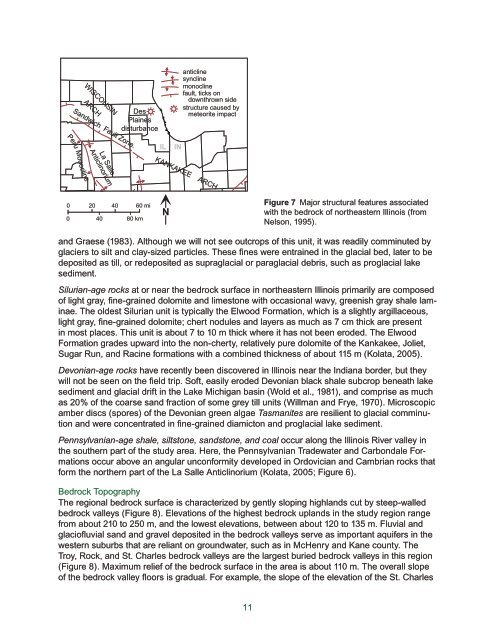Deglacial History and Paleoenvironments of Northeastern Illinois
Deglacial History and Paleoenvironments of Northeastern Illinois
Deglacial History and Paleoenvironments of Northeastern Illinois
- No tags were found...
You also want an ePaper? Increase the reach of your titles
YUMPU automatically turns print PDFs into web optimized ePapers that Google loves.
WISCONSINARCHS<strong>and</strong>wich Fault Zone.DesPlainesdisturbanceanticlinesynclinemonoclinefault, ticks ondownthrown sidestructure caused bymeteorite impactPeru MonoclineILINAnticlinoriumLa SalleKANKAKEE ARCH0020 40 60 mi40 80 kmNFigure 7 Major structural features associatedwith the bedrock <strong>of</strong> northeastern <strong>Illinois</strong> (fromNelson, 1995).<strong>and</strong> Graese (1983). Although we will not see outcrops <strong>of</strong> this unit, it was readily comminuted byglaciers to silt <strong>and</strong> clay-sized particles. These fines were entrained in the glacial bed, later to bedeposited as till, or redeposited as supraglacial or paraglacial debris, such as proglacial lakesediment.Silurian-age rocks at or near the bedrock surface in northeastern <strong>Illinois</strong> primarily are composed<strong>of</strong> light gray, fine-grained dolomite <strong>and</strong> limestone with occasional wavy, greenish gray shale laminae.The oldest Silurian unit is typically the Elwood Formation, which is a slightly argillaceous,light gray, fine-grained dolomite; chert nodules <strong>and</strong> layers as much as 7 cm thick are presentin most places. This unit is about 7 to 10 m thick where it has not been eroded. The ElwoodFormation grades upward into the non-cherty, relatively pure dolomite <strong>of</strong> the Kankakee, Joliet,Sugar Run, <strong>and</strong> Racine formations with a combined thickness <strong>of</strong> about 115 m (Kolata, 2005).Devonian-age rocks have recently been discovered in <strong>Illinois</strong> near the Indiana border, but theywill not be seen on the field trip. S<strong>of</strong>t, easily eroded Devonian black shale subcrop beneath lakesediment <strong>and</strong> glacial drift in the Lake Michigan basin (Wold et al., 1981), <strong>and</strong> comprise as muchas 20% <strong>of</strong> the coarse s<strong>and</strong> fraction <strong>of</strong> some grey till units (Willman <strong>and</strong> Frye, 1970). Microscopicamber discs (spores) <strong>of</strong> the Devonian green algae Tasmanites are resilient to glacial comminution<strong>and</strong> were concentrated in fine-grained diamicton <strong>and</strong> proglacial lake sediment.Pennsylvanian-age shale, siltstone, s<strong>and</strong>stone, <strong>and</strong> coal occur along the <strong>Illinois</strong> River valley inthe southern part <strong>of</strong> the study area. Here, the Pennsylvanian Tradewater <strong>and</strong> Carbondale Formationsoccur above an angular unconformity developed in Ordovician <strong>and</strong> Cambrian rocks thatform the northern part <strong>of</strong> the La Salle Anticlinorium (Kolata, 2005; Figure 6).Bedrock TopographyThe regional bedrock surface is characterized by gently sloping highl<strong>and</strong>s cut by steep-walledbedrock valleys (Figure 8). Elevations <strong>of</strong> the highest bedrock upl<strong>and</strong>s in the study region rangefrom about 210 to 250 m, <strong>and</strong> the lowest elevations, between about 120 to 135 m. Fluvial <strong>and</strong>glaci<strong>of</strong>luvial s<strong>and</strong> <strong>and</strong> gravel deposited in the bedrock valleys serve as important aquifers in thewestern suburbs that are reliant on groundwater, such as in McHenry <strong>and</strong> Kane county. TheTroy, Rock, <strong>and</strong> St. Charles bedrock valleys are the largest buried bedrock valleys in this region(Figure 8). Maximum relief <strong>of</strong> the bedrock surface in the area is about 110 m. The overall slope<strong>of</strong> the bedrock valley floors is gradual. For example, the slope <strong>of</strong> the elevation <strong>of</strong> the St. Charles11
















